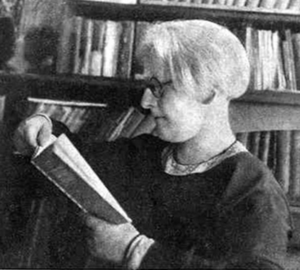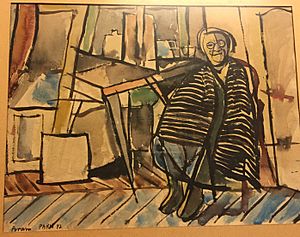Etta Federn facts for kids
Etta Federn-Kohlhaas (born April 28, 1883 – died May 9, 1951), also known as Marietta Federn, was a talented writer, translator, and teacher. She was a very important figure in German literature before World War II. In the 1920s and 1930s, she was active in the anarcho-syndicalist movement in Germany and Spain. This movement believed in workers' rights and freedom.
Etta grew up in Vienna, Austria. In 1905, she moved to Berlin, Germany. There, she became a literary critic, which means she wrote reviews about books. She also worked as a translator, novelist, and wrote biographies about famous people. In 1932, when the Nazis started to gain power in Germany, she moved to Barcelona, Spain. She joined an anarchist-feminist group called Mujeres Libres, which means "Free Women." She became a writer and teacher for this group.
In 1938, near the end of the Spanish Civil War, Etta had to flee to France. During World War II, she was hunted by the Gestapo (the Nazi secret police) because she was Jewish and a member of the French Resistance. The French Resistance was a group that fought against the Nazi occupation. Etta survived the war by staying in hiding.
She published 23 books in Germany, including translations from many languages like Danish, Russian, and English. She also published two books while living in Spain.
Etta Federn's life, especially her strong love for her two sons, inspired a play called Skuggan av Mart (Marty's Shadow). This play was written in 1948 by Stig Dagerman, a famous Swedish author. The play was first performed in Stockholm, Sweden, and has been shown in many other countries since then.
Her Family Life
Etta Federn grew up in Vienna in a Jewish family that was not very religious. Her mother, Ernestine Spitzer, was a suffragist, meaning she worked to get women the right to vote. Her father, Dr. Salomon Federn, was a well-known doctor who helped develop ways to check blood pressure.
Etta had several siblings who also became successful. Her brother Paul Federn was a psychoanalyst, a type of doctor who helps people with their thoughts and feelings. He was an early student of Sigmund Freud, a very famous figure in psychology. Paul was an expert in understanding how the mind works and helped people with mental health issues.
Her brother Walther Federn was a leading economic journalist in Austria. Her brother Karl Federn, who moved to the UK, was a lawyer and wrote books about literature and politics.
Her sister Else Federn was a social worker in Vienna. She was active in helping communities. A park in Vienna was named after her in 2013.
Etta Federn was married twice. Her first husband was Max Bruno Kirmsse, a German teacher. Her second husband was Peter Paul Kohlhaas, an artist who created illustrations. She had two sons, Hans and Michael, one from each marriage. Her older son, Hans, was known as Capitaine Jean in the French Resistance. He was killed during the war in 1944.
Her Work and Contributions
In Vienna and Berlin, Etta Federn studied literary history, German language, and Ancient Greek. She wrote many different types of works, including articles, biographies, and poetry. She also wrote a novel for young adults called Ein Sonnenjahr (A Year of Sun). As a journalist, she was a literary critic for the Berliner Tageblatt, an important newspaper.
She wrote biographies of famous people like Dante Alighieri, a great Italian poet, and Christiane Vulpius, the wife of the German writer Johann von Goethe. In 1927, she published a biography of Walther Rathenau, who was Germany's Foreign Minister. He was killed in 1922 by right-wing terrorists who disliked Jewish people. A review of her book in the New York Times said it was "amazingly clear and precise." After this book came out, Etta started receiving threats from the Nazis.
During the 1920s, Etta became friends with a group of anarchists, including Emma Goldman and Milly Witkop Rocker. She wrote for various anarchist newspapers and journals.
In Berlin, Etta also met and translated works by several Jewish poets from Poland who wrote in Yiddish. In 1931, her translation of a Yiddish poetry book called Fischerdorf (Fishing Village) was published. The famous writer Thomas Mann praised the book. Sadly, this work was later destroyed during the Nazi book burnings.
In 1932, Etta realized she could no longer publish her writings in Germany because of the Nazis. So, she moved with her sons to Barcelona, Spain. There, she joined the anarchist movement Mujeres Libres (Free Women). This group helped women by providing things like maternity centers, daycare, and reading classes. Etta learned Spanish and became the director of four progressive schools in the city of Blanes. She taught both teachers and children about values like peace and freedom. Starting in 1936, she wrote articles for the group's magazine, also called Mujeres Libres.
She believed that educated mothers could be great teachers for their children. She wrote: "Educated mothers relate their own experiences and sufferings to their children; they intuitively understand their feelings and expressions. They are good educators, as they are also friends of the children they educate."
In 1938, as the fascists led by Francisco Franco bombed Barcelona and won the Spanish Civil War, Etta fled to France. There, she was held in camps for foreign refugees. She spent the war hiding in Lyon, sometimes in a monastery. She also did translation work for the French Resistance.
Etta spent her last years in Paris. Her relatives in the USA helped support her. She also did palm readings, using her understanding of people's minds. Because her son was killed fighting for the Resistance, she was given French citizenship. After many years of poor health, tiredness, and sadness over her son's death, she passed away in Paris in 1951.
Her Translations
Etta Federn translated many important works into German from different languages:
- H.C. Andersens Märchen, which are the fairy tales of Hans Christian Andersen, translated from Danish in 1923.
- Shakespeare-Lieder, the sonnets of William Shakespeare, translated from English in 1925.
- Wege der liebe : drei Erzählungen (The Ways of Love: Three Stories), by Alexandra Kollontai, translated from Russian in 1925.
- Gesichte, poems by Samuel Lewin, translated from Yiddish in 1928.
- Fischerdorf (Fishing Village), poems by A. N. Stencl, translated from Yiddish in 1931.
- Sturm der Revolution (The Storm of Revolution), poems by Saumyendranath Tagore, translated from Bengali in 1931.
- Anakreon, poems by Anacreon, translated from Ancient Greek in 1935.
See also
 In Spanish: Etta Federn para niños
In Spanish: Etta Federn para niños



